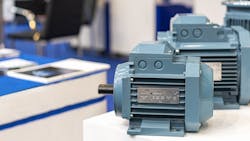Inductive Position Sensors Improve Industrial Motor Control
What you’ll learn:
- The benefits of a dual inductive rotary sensor.
- How inductive position sensors are designed to improve motor precision, motor control, and motor performance in industrial applications and requirements.
Constant progress in everything from manufacturing to transportation and entertainment often relies on boosting the performance of our machines by improving our ability to control them with increasing precision.
At the heart of many modern machines is at least one motor. An aspect to improving robots, elevators, automobiles, power tools, and more is controlling their motors with greater precision. The motor performance depends on precision control and precision motor control depends on precise detection of a motor’s position. The precise detection depends on increasing accurate sensor technology.
To boost motor precision, motor control, and motor performance, designers can now make use of inductive position sensors that offer new levels of positioning accuracy.
Optical and Magnetic Encoders: Features and Limitations
Magnetic encoders and optical encoders all take advantage of the relationship between changes in the position of the motor and its speed.
There are several kinds of magnetic encoders, but they all rely on variations of the same phenomenon: The motor is outfitted in some manner with one or more magnets. As these magnets move relative to a magnetic detector, the magnetic field changes in proportion to their relative movement.
The resolution of the different kinds of magnetic encoders varies, and in some instances can be quite low, measuring in only a couple hundred pulses per revolution (PPR). Higher accuracy depends on precise manufacturing. Size and weight vary by type. They can also be adversely affected by temperature extremes.
One drawback of magnetic sensors is when used in applications subject to electromagnetic interference (EMI), they might be unreliable if not unusable.
Optical encoders detect pulses of light. A basic implementation is to outfit a motor with a disk-shaped grate. Photodiodes detect light pulses on or through the grate as it spins (the sequence of light pulses constitutes the “code,” hence the term “optical encoder”). The technique determines both the rotational speed and the position of the motor.
Optical encoders are impervious to magnetic fields. They can have high resolution and provide good accuracy, but their performance may depend on careful installation.
Such encoders can be easily compromised by environmental contaminants such as dirt, soot, or even moisture. They too may be adversely affected by temperature extremes. With any of these sensors, high speeds are typically achieved at the expense of accuracy, which always costs more.
Inductive Sensors
The third type of sensor used with motors are inductive sensors. While induction sensors are in fact based on magnets, they’re not measuring changes in the magnetic field. Instead, induced current is measured.
The magnetic detector senses the rotation of gears. When the teeth of the gear pass the sensor, it creates a varying flux that induces a proportional voltage in the sensor. The voltage can be correlated with the speed and direction of the rotation.
Inductive sensors have been used for roughly a century. Inductive position sensor solutions are generally insensitive to vibration, temperature variations, and environmental contaminants. Mechanically, they tend to be simpler and therefore more reliable.
Over the last two decades inductive sensors have become increasingly popular in the automotive market. The inductive sensors used in automotive are designed to be low cost and highly reliable. They also happen to be low-speed and low-accuracy, which was suitable for the needs of that particular application. However, inductive sensors could achieve better performance.
Dual Inductive Rotary Sensor is Absolute
One solution is the dual inductive rotary sensor, which is a new variant of the inductive sensor. These inductive position sensors offer high speed and high accuracy.
The device’s accuracy is better than ±50 arcsec for a 38-mm sensor. It has full accuracy up to 6,000 RPM (though it can operate far beyond, at speeds up to 100,000 RPM maximum). It has 20-bit, single-turn resolution output and 24-bit multi-turn resolution output.
It’s an absolute encoder (versus an incremental encoder), meaning it can provide position data even when the rotor isn’t moving.
The standard module has an embedded microcontroller (MCU)—Arm Cortex-M0—with firmware. It outputs position and velocity instead of raw analog signals. The module’s flexible configuration capabilities allow for connection to a variety of inductive sensor patterns, and it offers a range of digital output formats.
The approach is mechanically simple, with a reduced number of components. It also requires a minimal number of external components (e.g., a bypass capacitor, tuning capacitor, etc). It has plug-and-play capabilities, is relatively easy to calibrate, and features error correction/diagnostics, making it easy to install and to operate. Like other inductive sensors, it is robust, safe, and reliable. It’s offered in a standard module, but the basic design is conducive to other configurations.
The integrated solution is designed for industrial applications and requirements. The dual inductive position sensor can be used where medium- and high-end optical encoders are currently in place, and in applications such as robotics, industrial drives, factory-automation systems, and a wide variety of industrial machinery.
Whenever a designer is evaluating sensor options, it’s important not only to meet the operational requirements of the application, but also vital to consider the long-term vitality of the application. With the dual induction rotary position sensor, the reduced component count, extended operational lifespan, and simplicity of calibration will translate into a lower overall cost of ownership.
About the Author
Alessandro Maggioni
Senior Regional Marketing Manager of EMEA, onsemi
Alessandro Maggioni is senior regional marketing manager of EMEA in onsemi’s ASG (Advanced Solutions Group). He has more than 18 years of experience in the semiconductor industry, starting as an applications engineer, but mostly serving in marketing roles.
